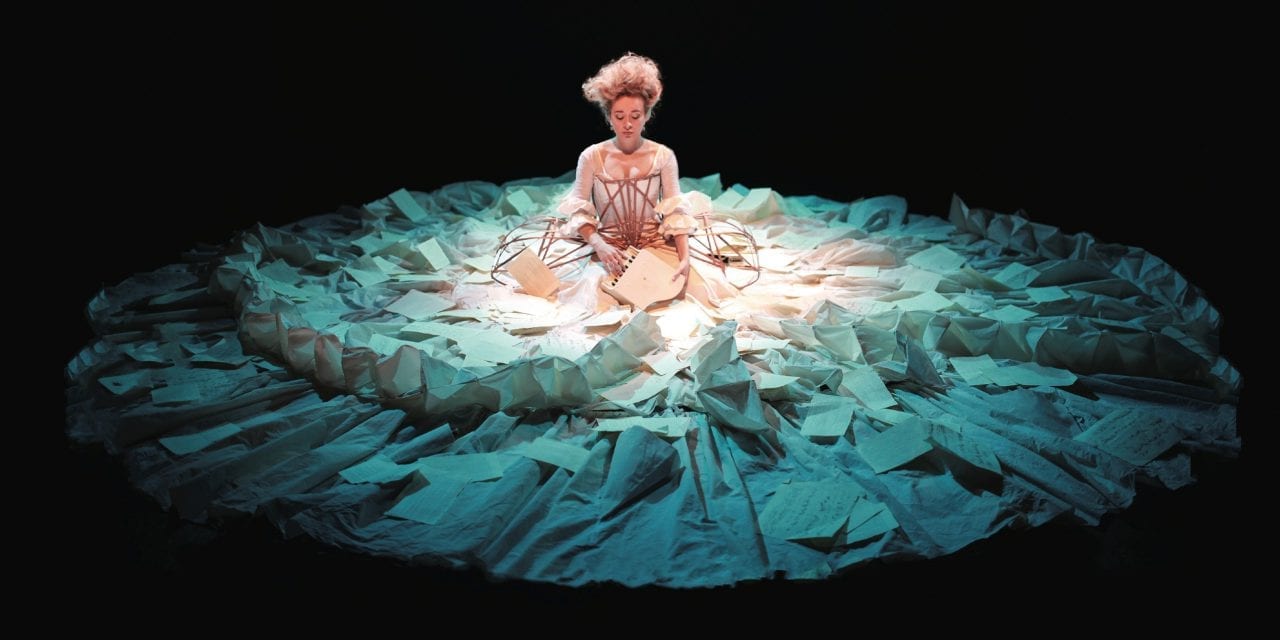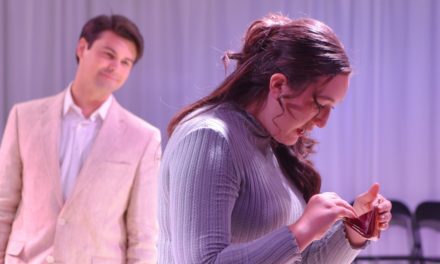PROVO — For a sixth year, Off The Map, BYU’s international theatre festival, has brought diverse foreign theatre conveniently to a Utah location. This year’s offerings are a gentle, “multi-sensory,” two-man puppet production for all ages (4+) and an intense one-woman historical biography for the more mature. The two shows could not be more different, nor more worth experiencing.
The Man Who Planted Trees

Off the Map productions play in Utah through January 26, 2019.
At first take, an old French story about a quiet herdsman who spends decades poking holes in back country dirt is dubious material for engaging children’s theater. Puppet State Theatre’s adaptation of Jean Giono’s “L’homme Qui Plantait des Arbres” contains none of the frantic pacing, dazzling color, brash novelty and noise typical of current children’s entertainment. Instead, the production presents simple storytelling, deep themes, and puppetry that turns the mere wag of a tiny dog tail into a big laugh—plenty to make an absorbing evening.
The story is deceptively simple. A man out walking encounters a shepherd who, after the death of his wife and son, finds meaning in planting tree seeds, anonymously seeking to heal his land and, by extension, his civilization. Despite knowing that half the seeds will die and more will be lost to hungry birds and beasts, to the greed of humans, even to his own misjudgment, the man methodically plants 100 seeds a day. With inexorable persistence he gradually begins to save the world. Interpret as you will: is he an environmental activist? A pacifist? A Good Shepard ministering? In every way, the story is a beautiful lesson of hope.
Again contrary to expectations, the play is neither heavy nor heavy handed. Writer and performer Richard Medrington and his cohort Rick Conte tell the tale almost as a parent would tell a bedtime story, connecting directly to the audience with little jokes and a few squirts of water. They make good use of a few representative set pieces (such as wicker trees), some small props, and several puppets, including a dog that talks and a man that does not. (Set and puppet design by Allie Cohen).

Richard Medrington and Rick Conte in The Man Who Planted Trees.
Parents can be assured that the play is a perfect introduction to theater for their kids, because the actors sneak in little explanations of how theater works. The hour run-time goes by quickly. Be aware that audience members with extreme sensory sensitivities might be bothered by brief uses of lavender and mint oil wafted into the house.
Medrington and Conte have performed this play together what they estimate to be between 1600 and 1800 times, everywhere from Scotland to Australia, yet their performance seemed as fresh as if it were happening for the first time. Their obvious love of “playing” and love for the audience is utterly endearing. As my husband pointed out, they are doing artistically what the fictional shepherd did physically—patiently planting little life-affirming seeds in hearts all around the world.
The Other Mozart
Directed by Isaac Byrne, and written and embodied by Polish actress Sylvia Milo, The Other Mozart is a passionate resurrection of a woman silenced and forgotten, namely Maria Anna “Nanneril” Mozart, musical genius Amadeus’s real life, equally talented sister. What changed this female Mozart from a child prodigy, wildly acclaimed for her performances in the capitals of Europe, to an ignored third wife of a crude nobleman (with a houseful of ignorant children), trying desperately to keep her soul alive by practicing for hours on a ruined, soundless clavichord?

Sylvia Milo as Maria Anna “Nanneril” Mozart.
Milo utterly commits to her reenactment of Nanneril’s life, from a somewhat annoying giddy child prancing about in modest undergarments to a resigned older woman caged in an elaborate metal corset. She is precise and believable with her use of different voices and accents as her character remembers her family interactions and reads from their letters.
These letters comprise the majority of props used, snatched up from the floor and tossed about in frustration. The production design is profoundly symbolic. The performance begins before Milo’s appearance: an enormous, frothy, white gown (by designer Anna Sroka) is spread like a round rug on the stage gleaming and waiting to be inhabited. Scattered on the 18-feet of the circumference of the garment are the letters. All the action will take place within this space; Nanneril is to be literally hemmed in and marginalized.
The ominous accompaniment to the waiting garment is the sound of nearly random chimes, almost but not quite discordant—potential music disrupted. Sound designer and composer Nathan Davis’s superb soundtrack supports the action and expresses what the character cannot as her voice is progressively drowned out by her brother’s famous melodies. (Additional design and composition was contributed by Phyllis Chen, Marianna Marines, L. Mozart, and of course Amadeus Mozart).
In the question session after the performance, Milo related that she spent five years meticulously researching the Mozarts’ history and reading correspondences to Nanneril from family members to incorporate their actual words in the play. Sadly, none of Nanneril’s compositions nor her own letters were preserved by anyone. Though I’ll hazard a guess that anyone who witnesses this production will ever forget her.
The Man Who Planted Trees plays nightly through January 26 at 6:00 PM, with additional performances on January 25 at 10 AM and January 26 at 1:30 PM, in the Nelke Experimental Theatre in the Harris Fine Arts Center on the campus of Brigham Young University. Tickets are $13-17.
The Other Mozart plays nightly through January 26 at 8:00 PM in the Pardoe Theatre in the Harris Fine Arts Center on the campus of Brigham Young University. Tickets are $13-17.





